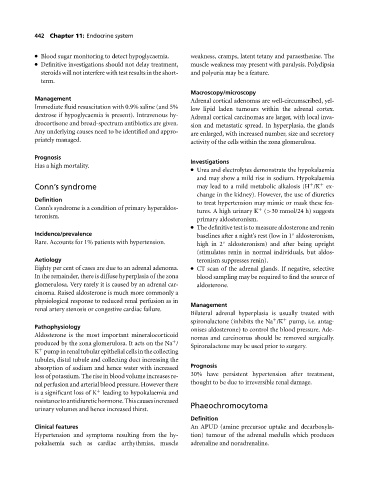Page 446 - Medicine and Surgery
P. 446
P1: FAW
BLUK007-11 BLUK007-Kendall May 25, 2005 8:5 Char Count= 0
442 Chapter 11: Endocrine system
Blood sugar monitoring to detect hypoglycaemia. weakness, cramps, latent tetany and paraesthesiae. The
Definitive investigations should not delay treatment, muscle weakness may present with paralysis. Polydipsia
steroids will not interfere with test results in the short- and polyuria may be a feature.
term.
Macroscopy/microscopy
Management Adrenal cortical adenomas are well-circumscribed, yel-
Immediate fluid resuscitation with 0.9% saline (and 5% low lipid laden tumours within the adrenal cortex.
dextrose if hypoglycaemia is present). Intravenous hy- Adrenal cortical carcinomas are larger, with local inva-
drocortisone and broad-spectrum antibiotics are given. sion and metastatic spread. In hyperplasia, the glands
Any underlying causes need to be identified and appro- are enlarged, with increased number, size and secretory
priately managed. activity of the cells within the zona glomerulosa.
Prognosis
Investigations
Hasa high mortality.
Urea and electrolytes demonstrate the hypokalaemia
and may show a mild rise in sodium. Hypokalaemia
Conn’s syndrome may lead to a mild metabolic alkalosis (H /K ex-
+
+
change in the kidney). However, the use of diuretics
Definition
to treat hypertension may mimic or mask these fea-
Conn’s syndrome is a condition of primary hyperaldos-
+
tures. A high urinary K (>30 mmol/24 h) suggests
teronism.
primary aldosteronism.
The definitive test is to measure aldosterone and renin
Incidence/prevalence baselines after a night’s rest (low in 1 aldosteronism,
◦
Rare. Accounts for 1% patients with hypertension. high in 2 aldosteronism) and after being upright
◦
(stimulates renin in normal individuals, but aldos-
Aetiology teronism suppresses renin).
Eighty percent of cases are due to an adrenal adenoma. CT scan of the adrenal glands. If negative, selective
In the remainder, there is diffuse hyperplasia of the zona blood sampling may be required to find the source of
glomerulosa. Very rarely it is caused by an adrenal car- aldosterone.
cinoma. Raised aldosterone is much more commonly a
physiological response to reduced renal perfusion as in
Management
renal artery stenosis or congestive cardiac failure.
Bilateral adrenal hyperplasia is usually treated with
spironalactone (inhibits the Na /K pump, i.e. antag-
+
+
Pathophysiology
onises aldosterone) to control the blood pressure. Ade-
Aldosterone is the most important mineralocorticoid
nomas and carcinomas should be removed surgically.
+
produced by the zona glomerulosa. It acts on the Na /
Spironalactone may be used prior to surgery.
K pump in renal tubular epithelial cells in the collecting
+
tubules, distal tubule and collecting duct increasing the
absorption of sodium and hence water with increased Prognosis
loss of potassium. The rise in blood volume increases re- 30% have persistent hypertension after treatment,
nal perfusion and arterial blood pressure. However there thought to be due to irreversible renal damage.
is a significant loss of K leading to hypokalaemia and
+
resistancetoantidiuretichormone.Thiscausesincreased Phaeochromocytoma
urinary volumes and hence increased thirst.
Definition
Clinical features An APUD (amine precursor uptake and decarboxyla-
Hypertension and symptoms resulting from the hy- tion) tumour of the adrenal medulla which produces
pokalaemia such as cardiac arrhythmias, muscle adrenaline and noradrenaline.

